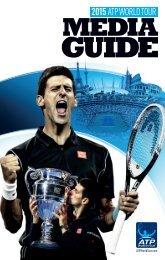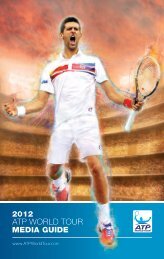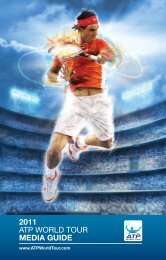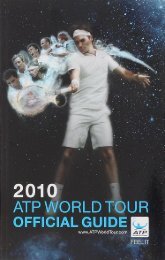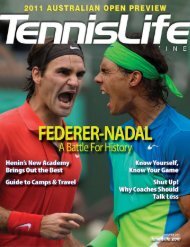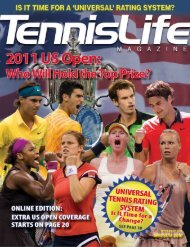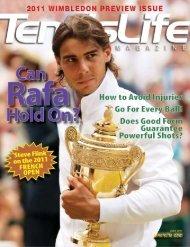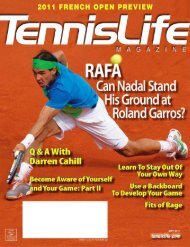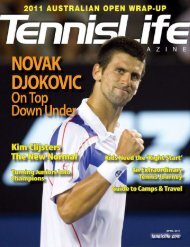A Champion's Mind - Pete Sampras
www.tennismoscow.me Insta:TENNISMOSCOW
www.tennismoscow.me Insta:TENNISMOSCOW
Create successful ePaper yourself
Turn your PDF publications into a flip-book with our unique Google optimized e-Paper software.
abandon the strategy for a few games, then come back to it. At times, it was very effective.<br />
Over the years, I also came to feel that if I stayed with him, I could slowly overpower him—in the end,<br />
he was more of a finesse guy than a power guy.<br />
WAYNE FERREIRA (7–6) . . . Now there’s a surprise for you, right? I’m not even sure why Ferreira gave me<br />
problems. He certainly never worried me the way some guys did. He moved well, returned well, and had<br />
a fine serve and a huge forehand, but most of all he came into matches with me with a really positive<br />
outlook.<br />
The real question was why Ferreira could play me so tough but look so fragile, mentally, and falter<br />
against so many other, weaker, guys. But that’s one for him to answer. One thing was for sure—there was<br />
no pressure when he played me. It was all gravy for him. I apparently motivated him and made him a real<br />
warrior, mentally. He beat me on a few occasions when I was really playing well, and all I could do was<br />
shrug and say, “That’s Ferreira for you.”<br />
LLEYTON HEWITT (4–5) . . . He loved players who served and volleyed and tried to pressure him, so I<br />
played right into his hands—as he demonstrated in that U.S. Open final of 2001. Lleyton was one of the<br />
few guys who really could resist the onslaught of a high-quality attacker. It was very tough to get the ball<br />
by him, or to ace him. He was quicker than Andre, and therefore passed a little better. Lleyton relied on<br />
foot speed and quickness to outmaneuver opponents, and he was young enough to run and concentrate all<br />
day if need be. He was a lot like Michael Chang, right down to the way he loved having a target—a guy at<br />
the net, forcing him to select a specific shot and placement.<br />
Lleyton was tough, too—street-fighter tough. But I never had trouble with that. Psychologically, this is a<br />
pretty rough game, and Lleyton’s intensity rubbed a lot of guys the wrong way. He was always yelling,<br />
“Come awwwwwn!” I didn’t mind that—it was his own energy he was wasting. For a period I felt that<br />
Lleyton might really dominate. His game translated well from surface to surface, and the guys had a hard<br />
time figuring out a strategy against him. He won the U.S. Open and followed it up with a win at<br />
Wimbledon, but then a few things happened.<br />
For one, Roger Federer improved, and he figured Lleyton out cold. The game in general also improved<br />
while Lleyton was at the top. Guys were playing with a little more power, partly thanks to advances in<br />
racket technology, but fewer of them were playing into Hewitt’s hands. Lleyton liked having a target, but<br />
in his era guys stopped coming to the net. Hewitt was a victim of his time.<br />
As Lleyton became more and more vulnerable, he was having to work harder and harder to win<br />
matches. When you play with a grinder’s mentality like Lleyton did, you rely a lot on mental intensity. But<br />
no matter how tough you are, it’s hard to keep up that hardworking, patient style, week in, week out.<br />
Eventually it catches up with you and you get a little burned out. Then the vultures gather.<br />
GORAN IVANISEVIC (12–6) . . . Goran’s greatest asset was that huge lefty serve. It was just too damned<br />
good most of the time, especially on grass. It wasn’t even a matter of that heavy slice a lefty can produce.<br />
Goran hit his serve with a fast, almost rushed action, and the result was a quick, heavy ball that stayed<br />
low.<br />
Goran was smart—he knew that he wasn’t going to win many baseline rallies, or even volley his way<br />
to titles the way Stefan Edberg could. He designed his entire game plan around that serve, and he<br />
designed it to win Wimbledon—the tournament where my own game worked best. Goran’s second<br />
delivery was big, but I always felt I could find it, get some stick on it. That was partly because I wasn’t<br />
that worried about Goran’s second shot. I could play my return a little safer and still think I had a chance,<br />
which wasn’t the case with a Rafter or an Edberg.




